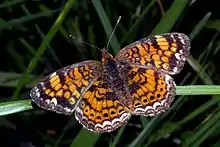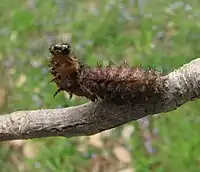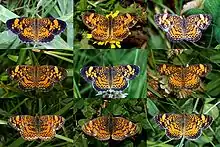Pearl crescent
The pearl crescent (Phyciodes tharos) is a butterfly of North America. It is found in all parts of the United States except the west coast, and throughout Mexico and parts of southern Canada, in particular Ontario. Its habitat is open areas such as pastures, road edges, vacant lots, fields, open pine woods. Its pattern is quite variable. Males usually have black antenna knobs. Its upperside is orange with black borders; postmedian and submarginal areas are crossed by fine black marks. The underside of the hindwing has a dark marginal patch containing a light-colored crescent.
| Pearl crescent | |
|---|---|
 | |
| Scientific classification | |
| Kingdom: | Animalia |
| Phylum: | Arthropoda |
| Class: | Insecta |
| Order: | Lepidoptera |
| Family: | Nymphalidae |
| Genus: | Phyciodes |
| Species: | P. tharos |
| Binomial name | |
| Phyciodes tharos (Drury, [1773]) | |
The wingspan is from 21 to 34 mm.[2] The species has several broods throughout the year, from April–November in the north, and throughout the year in the deep south and Mexico.



Adults find nectar from a great variety of flowers including dogbane, swamp milkweed, shepherd's needle, asters, and winter cress. Males patrol open areas for females. The eggs are laid in small batches on the underside of host plant leaves. Caterpillars eat the leaves and are gregarious when young. Hibernation is by third-stage caterpillars.
Similar species
- Phyciodes batesii – tawny crescent
- Phyciodes cocyta – northern crescent
References
- "NatureServe Explorer 2.0 Phyciodes tharos Pearl Crescent". explorer.natureserve.org. Retrieved 3 October 2020.
- "Pearl Crescent (Phyciodes tharos) (Drury, 1773)". Butterflies of Canada. Canadian Biodiversity Information Facility (CBIF).
- Brock, Jim P.; Kaufman, Kenn (2003). Butterflies of North America. Boston: Houghton Mifflin. ISBN 0-618-15312-8.
- Glassberg, Jeffrey (1999). Butterflies through Binoculars: The East: A Field Guide to the Butterflies of Eastern North America. New York: Oxford University Press. ISBN 0-19-510668-7.
- Scott, James A. (1986). The Butterflies of North America: A Natural History and Field Guide. Stanford University Press. ISBN 0-8047-2013-4.
- "Species Phyciodes tharos - Pearl crescent". BugGuide.
